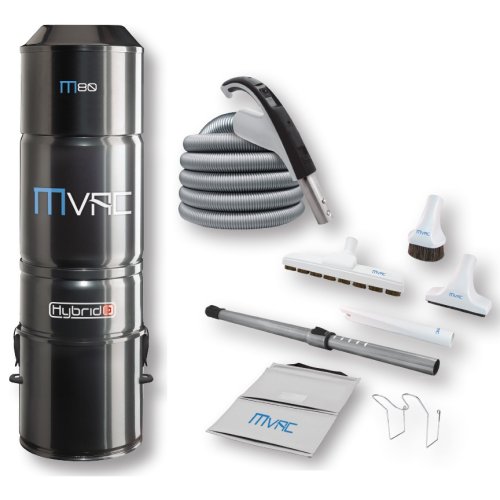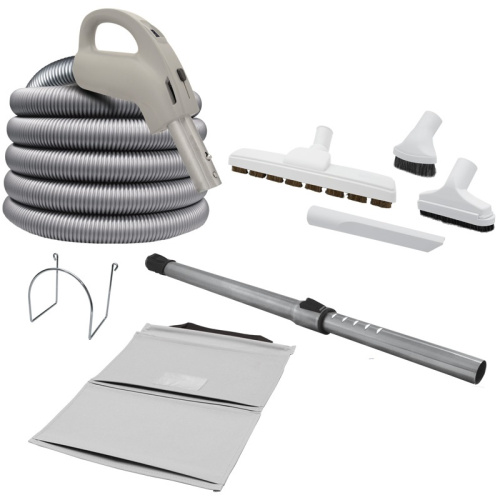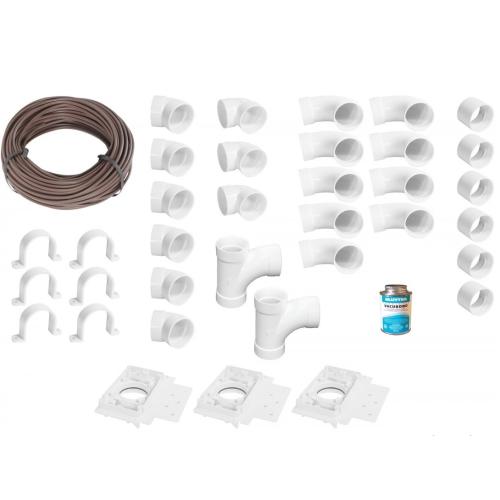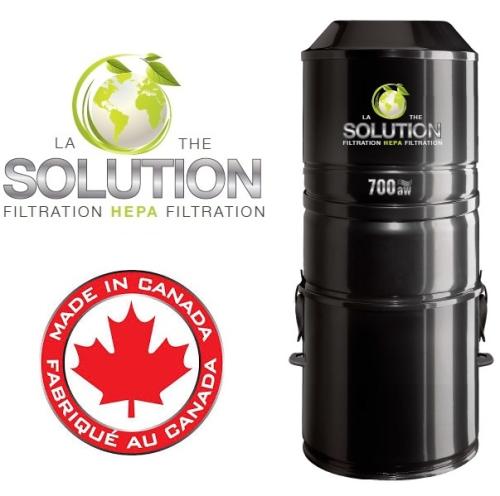







A central vacuum system is the most efficient and fastest tool for cleaning your home. Hundreds of thousands of homes in Canada and the United States are equipped with a central vacuum during construction to facilitate the installation of the piping system that connects to it.
For approximately $1,000 to $2,000, you can equip your home with a central vacuum system tailored to your needs, including accessories configured for your type of floorings and surfaces to clean, with installation materials and labor included. On the other hand, a good quality portable vacuum will cost you between $500 and $1,000, with some models going up to $2,500! In addition to spending a fortune on a small vacuum with limited and inconvenient accessories, you will need to replace it every 3 to 7 years on average. Imagine the money you will save by choosing a central vacuum today!
Certainly!
However, this type of installation is more complex because the walls are closed, and you need to be handy and imaginative!
The ideal is to first decide where the central vacuum motor unit will be located. If the compartment under a staircase is accessible, a closet, or a mechanical room, and from this predetermined location it is possible to install an vacuum intlet port in a corridor of the house, you have an easy solution!
A closet or wardrobe can serve well as a path to access an upper floor. In this kind of space, even if a section of piping is visible, it will be very discreet and allow you to achieve your goal of having an intlet valve on each floor.
As a last resort, to reach all areas of the house through a single vacuum suction port, there are flexible hoses up to 60 feet in length.
A vacuum inlet valve can even be easily installed directly on the main power unit to allow you to reach other places and benefit from the power and convenience of a central vacuum.
The power of a central vacuum is unmatched. It is much more powerful than traditional portable vacuum cleaners, uprights, or battery-powered vacuums. Picking up crumbs, dust, or debris like small rocks on the floor is easy, and there is no need to pass the brush two or three times to achieve it!
Several units of measurement
What is the inch of water ("H20) for a vacuum?
Inch of H20: The inch of water or "H20 is the most reliable unit of measurement to measure the raw suction power of a central vacuum. The higher the inches H20, the more it will lift large objects.
What is the CFM for a vacuum?
Airflow CFM : Airflow is also a unit of measurement to consider. However, this unit is more relevant for very large houses, larger commercial projects such as hotels with many floors or many inlet valves. Airflow is measured in cubic feet per minute, and the more air the motor can move (not to be confused with suction power and "H20), the higher the CFM numbers will be.
What is Airwatt for a vacuum?
Air Watts or Airwatts: Airwatts is a unit of measurement obtained by a mathematical formula relating CFM and "H20. It cannot be measured with a gauge.
The formula is as follows: CFM x "H20 / 8.5 = Air Watts
Although Airwatt is a widely used unit of measurement, it does not represent the power of the central vacuum. Some very powerful vacuums have a smaller Airwatt than some less powerful models. It can be confusing to use only the Air Watts.
In conclusion, to have a complete picture of the power and efficiency of a central vacuum or even a more traditional vacuum, it is important to consider the three measurement data, "H20, CFM, and Airwatt.
Remember that for a traditional family home, the inches of H20 ("H20) is the most important unit of measurement for raw suction power.
In a house, air quality is one of the most important factors to consider. We want to avoid the dust collected on the floor from spreading into the air. With a central vacuum system or central vacuum with HEPA (High Efficiency Particulate Absorbing Filter) certification, dust is filtered up to 99.5% efficiency.
The vast majority of central vacuums today have a fabric / cloth or paper recovery bag to capture and trap dust and debris. The bag, in addition to the filter, allows the central vacuum to filter dirt twice rather than once. Maintaining a central vacuum with a bag is also much easier and less messy.
Central vacuums also have the option of being vented outside the house or apartment through an exhaust air outlet. The exhaust air outlet outside the house is 100% sealed, meaning that no dust is released into the air. For people with allergies and respiratory problems, this is the best option for your quality of life.
The central vacuum is considered much more environmentally friendly than traditional small portable vacuums or battery-powered vacuums. A central vacuum has a lifespan of over 15 years on average, and it can even go up to 40 years with certain types of motors. They are much less frequently found in landfills than small canisters or upright vacuums. Due to their larger capacity, we change the bag much less frequently. The bags of smaller vacuums also end up in large quantities in household waste bins. Finally, battery-powered vacuums have toxic products and heavy metals such as lithium and acid that will degrade in nature after their lifespan. Batteries from these machines are most of the time not adequatly recycled. For all these reasons, the central vacuum is much more environmentally friendly and eco-responsible.
Do you really still want to buy an upright vacuum? The question really arises!
All Right Reserved, Gestion Moriclo Inc 2025
Shoppers Approved SSL Security Certificates Youtube Channel Facebook Google Reviews